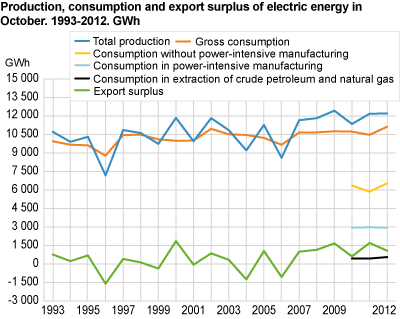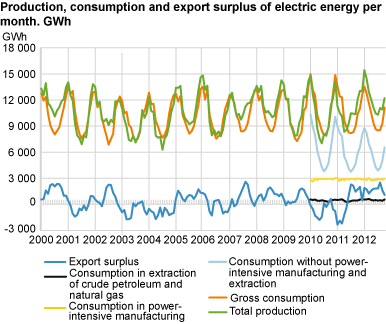Content
Published:
This is an archived release.
Record high electricity consumption
The total electricity consumption came to 11 131 GWh in October. This is 6.3 per cent higher compared with the same month in 2011 and the highest figure ever recorded for this month since the monthly electricity statistics started in 1979.
The high electricity consumption must be seen in conjunction with the relatively cold weather. The average temperature for Norway was 1 degree below normal in October this year and 2.8 degrees lower compared with the same month last year. The gross consumption of electricity encompasses consumption in the groups extraction of crude oil and natural gas, power-intensive manufacturing and electricity consumption excluding power-intensive manufacturing and extraction. Net loss, pump storage use and other own consumption in the power stations are also included.
Increase in electricity consumption excluding power-intensive manufacturing and extraction
Electricity consumption excluding power-intensive manufacturing and extraction amounted to 6 543 GWh in October 2012; an increase of 12 per cent compared with the same month in 2011. This may be seen in conjunction with the relatively low temperatures. Households, services and manufacturing other than the power-intensive manufacturing account for the majority of the electricity consumption excluding power-intensive manufacturing and extraction. Electricity consumption in households amounts to approximately 50 per cent of the electricity consumption excluding power-intensive manufacturing and extraction.
Rise in electricity consumption in extraction of crude oil and natural gas
Electricity consumption in plants for extraction of crude petroleum and natural gas on the mainland, including electricity distributed from the mainland to the Norwegian shelf, amounted to 561 GWh in October. This is 27 per cent more compared to the corresponding month last year. The electricity consumption in extraction on the mainland encompasses receiving and processing plants for crude oil and natural gas.
Small decrease in consumption in power-intensive manufacturing
Electricity consumption in power-intensive manufacturing was 2 941 GWh in October 2012. This is 1.3 per cent lower compared with October 2011. The decline may be seen in conjunction with closures of some wood processing establishments. Power-intensive manufacturing utilises electricity for the production of goods. Hence, the electricity consumption is not influenced by temperature.
High electricity generation
The electricity generation amounted to 12 211 GWh in October 2012. This is 0.3 per cent higher compared with the corresponding month last year and the second highest figure ever recorded for this month. The high electricity generation may be seen in conjunction with a large amount of water in the Norwegian reservoirs and a high demand for electricity. According to the Norwegian Water Resources and Energy Directorate, the reservoir filling was 91.6 per cent at the beginning of October. At the end of the month in week 43 the filling was 88.1 per cent. This is 1.2 percentage points higher than the same week in 2011 and 1.8 percentage points higher than the median filling for the corresponding week in the years 1990-2011.
High net export of power
Norway’s export of power totalled 1 573 GWh in October 2012, whereas imports came to 494 GWh. This gave a net export of 1 079 GWh. In the same month last year the net export totalled 1 704 GWh.
Tables:
Contact
-
Magne Holstad
E-mail: magne.holstad@ssb.no
tel.: (+47) 40 90 23 42
-
Ingvild Røstøen Ruen
E-mail: ingvild.ruen@ssb.no
tel.: (+47) 40 81 13 97
-
Tom Jonas Billit
E-mail: tom.billit@ssb.no
tel.: (+47) 40 81 13 45
-
Thomas Aanensen
E-mail: thomas.aanensen@ssb.no
tel.: (+47) 40 90 23 48


